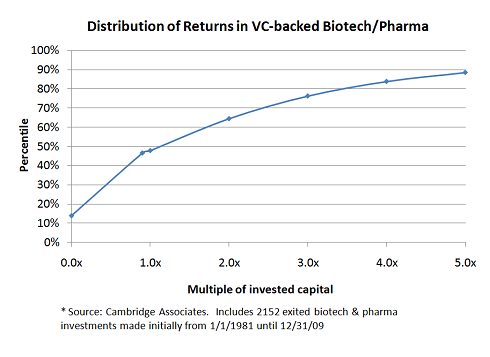As my first post of real content, I thought I’d tackle the question of what are the actual return distributions of venture capital investments in biotech startups (e.g., how many losers, how many winners) to set some context. And it will help explain my blog’s subtitle.
As a community, we’re full of faith-based believers in the biotech startup world – we all always believe the next one we start or invest in is going to be the big win. Along with that optimism, there’s a ton of mythology out there about which venture-backed biotech deals drove 20x returns, mostly nostalgic for the 1980-1990s. “Raise as much as you can, when you can” and other untrue axioms became dogma during those days. Lots of snippets of anecdotal evidence and hand-waving don’t overcome the reality though.
Gary Pisano at Harvard has written a good deal on overall public biotech returns and the sector’s underperformance, in part due to the certainty of scientific uncertainty. But on the private biotech side, we’re all so protective of specific deal returns and often bound by confidentiality, very little actually gets public. I’ve not seen a good piece of literature on venture-backed biotech distributions so I’ve done a quick analysis with some Cambridge Associates data.
Cambridge has tracked 2152 biotech and pharma investments made initially between 1981 and 2009 that have now been realized (exited). I’ve plotted the buckets of returns in the dataset as a cumulative distribution in the following graph:
Some conclusions:
- As if we needed to be reminded of this, roughly half of venture-backed biotech’s lose money. The total losses for the recent cohort are over-estimated as I didn’t have the detailed data on salvage values, but both sets of data have about 50% with a loss of capital.
- Real winners above 5x make up about 11.4% of biotech deals. So just shy of 1 out of 8 deals. Not a bad hit rate.
- The failure rate hasn’t changed much. See the chart below. While the post-bubble 2000’s have had slightly higher failure rate, the 1990s were nearly as bad. The curve for the recent vintage is slightly up-shifted but not sure how statistically relevant that is. [What has probably changed, and I don’t have the data here, is that the winners in the 1990s were more likely to be above 10x invested capital, whereas today that’s a far less common experience. We’re trying to change that, but the numbers are what they are.]

An obvious question then arises – what are the characteristics of the outlier returns in the top two deciles? The biggest driver I can tell is the inverse correlation between capital intensity and returns. If you can achieve a successful exit and still spend less equity capital, you’re likely to generate a much better return. Seems intuitive to some degree, but only if you assume that the exit values are largely capped. Reality in biotech is most “successful” exits are in the $200-500M range, despite the occasional outlier like the recent Plexxikon deal. Raising $150M+ in equity capital to get there isn’t so interesting. Raising $15-30M on the other hand…. But this cap on returns with capital intensity isn’t always the rule on the Tech side of the venture business. It is for some (like capital equipment plays, semi’s, etc..), but many number of their business models can just keep scaling. Facebook and Groupon have all raised a ton, but are worth gazillions more than that now. Biotech just isn’t scalable over the same time horizons as Info Tech. I won’t belabor the topic here, or go through the analytics, but if you’re interested it’s a prior article in Nature Biotech.
I think there are a few implications for early stage biotech investment strategies:
- Be conscious of gravity. Within the existing set of business models, failure rates have been a relative constant like gravity, given the reasonably unchanged 20 year hit rate. Investors should assume half their biotech deals will fail, and 15% are real hits; and entrepreneurs should at least know the odds. Channeling more capital to the 15% and less to the 50% is a key to success.
- We’ve got to do something radically different to change the model. Everyone says biotech takes a lot of money because its “regulated drug development” etc… We need to figure out how to do it differently, while improving the odds that winners emerge with more limited capital. We’re experimenting with ultra-virtual models, tighter links with pharma, deeper academic links, new corporate structures, etc… (Lots of good substrate for blog posts in the future).
- Improve the existing models. If #2 doesn’t work and we’ve got to keep building bricks-and-mortar biotech companies, we need to figure out how to live with the gravity of #1 by spending less equity capital to get to the “no-go” decision and shut down unsuccessful deals. Use other sources of capital like partnering dollars. Kill the losers fast, as often as required, and hopefully cheaply. And try to preserve a large piece of your winners so you can invest more in them.
In some ways, successful early stage biotech venture investing today is all about balancing a portfolio between smarter approaches to the realities of gravity and an appreciation of new potentially ‘zero gravity’ virtual worlds.
Hence the subtitle of my blog. A biotech optimist fighting gravity.
Note: this post has been edited and updated with more comprehensive data since it was originally posted in March 2011.






